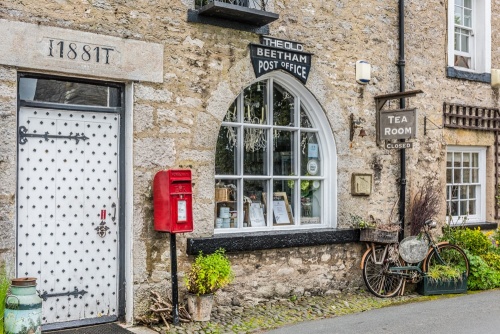
The historic Cumbria village of Beetham stands at the northern edge of the Arnside and Silverdale Area of Outstanding Natural Beauty. The village is the centre of a far-flung parish taking in Farleton, Carr Bank, Sandside, Whasett, Hale, and Storth. The village boasts a lovely mix of limestone cottages.
The manor of Beetham was owned for centuries by the Beetham (or Bethom) family. That changed in 1485 when Richard de Bethom was attainted after his support for Richard III at the Battle of Bosworth and his estates were granted to Thomas Stanley, the 1st Earl of Derby. The manor passed briefly to the Middleton family, then back to the Earls of Derby for the next three centuries.

St Michael's Church
There has been a church in Beetham since at least the late Saxon period. That early church was dedicated to St Lioba, a little-known 8th-century nun who accompanied St Boniface on his missionary work in Germany. After the Norman Conquest, the church was rededicated to St Michael and All Angels. Much of the building we see today dates to the 11th and 12th centuries, but you can still see Saxon stonework in the base of the tower.
Historical highlights include the effigies of Sir Robert and Lady Anne Middleton of Leighton Hall. The Middleton tomb bears many deep grooves, the result of it being used by Parliamentary soldiers to sharpen their blades during the Civil War.
There are several very good medieval panels of stained glass, including a coat of arms to Thomas Stanley, the 1st Earl of Derby, and a figure of Henry Bolingbroke (later Henry IV). Look for a later window depicting King Charles between the figures of St Alban and St Oswald.
Opposite the churchyard stands The Wheatsheaf, a traditional village inn that has been welcoming residents and visitors since 1609.

Heron Corn Mill
On the northern edge of the village stands a restored 18th-century mill on the west bank of the River Bela. There has been a mill in this spot since at least the 11th century but the mill we see today was erected in 1740. It has been completely restored and you can watch the miller grinding fresh flour on special milling days throughout the year.
Heron Corn Mill was built beside a natural limestone weir on the river Bela, and a natural cave through the rock now serves as a fish pass. The mill takes its name from the fact that there was a heronry near here in the 18th century. Though the heronry was closed long ago, you can still see herons and the elusive kingfisher near the mill pond.

The Old Post Office
Arguably the most picturesque building in Beetham is the Old Post Office on Church Street, which now acts as a combination tea room and village shop. The Old Post Office is part of a terrace of similar buildings all listed Grade II for their heritage interest.
Even though the door lintel bears the date 1881, the terrace of buildings dates to the 18th century. The date 1881 probably refers to a Victorian addition of an upper floor.
St Lioba's Shrine
Set into the slope of the hillside beside the lane running through the hamlet of Slack Head is a shrine to St Lioba, a reminder of the ancient saint's connection with Beetham. The shrine is a small opening in the rock face, now covered with an iron grill. Inside the grill is a statue of the saint.

The Fairy Steps
Overlooking the village on the top of Whin Scar is a natural rock formation known as the Fairy Steps, a narrow cleft in a limestone outcrop. According to legend, the Fairy Steps were made by faeries escaping from a witch's cauldron. It is said that if you can climb up or down the cleft without touching either side, faeries will appear and grant you a wish.
The Fairy Steps formed part of a coffin route from Arnside. Until 1866 Arnside had no church of its own and was part of Beetham parish. People attending church services had to climb up the Fairy Steps on their way to St Michael's Church in Beetham.
When a resident of Arnside died, the coffin bearing the corpse had to be carried up the Fairy Steps. You can still see the iron rings driven into the solid rock where ropes were used to haul coffins up the narrow passage.

There are 44 listed buildings in Beetham parish, including four Grade I listed ones (the highest designation). At the Milnethorpe end of the parish stands Dallam Tower, an early Georgian country house incorporating an earlier 17th-century building. Though the house itself is rarely open to the public, the 190-acre deer park has several public footpaths running through it.
At the junction of Stanley Street and the a6 at the southern edge of Beetham stands the Old School, built in 1827 to replace the grammar school founded here in 1663. The schoolhouse is now home to the Heron Theatre, a venue for cinema, drama, music, and art.
At the western end of Stanley Street stand a set of old village stocks, used for punishing miscreants.
Near the churchyard is the village war memorial, a Celtic style cross within semi-circular benches. On a plaque behind the cross are the names of those local people who died in WWI, while under that is a smaller plaque added after WWII bearing five more names.
At the southern edge of the village, just west of the A6, stands Beetham Hall, a 14th-century fortified manor surrounded by a curtain wall. The ruinous tower now forms part of a farmhouse. The tower was occupied by Royalists in the Civil War but they were forced to surrender to Parliamentary troops under Sir Thomas Fairfax. The tower was allowed to decay after the conflict.

There is another 14th-century fortified tower in the parish; at Storth, on the far side of Whin Scar, stands Hazelslack Tower, built in the late 1300s. The Tower is on private property so it can't be visited but you can clearly see it from a footpath that runs right next to it.
Near the Wheatsheaf stands Ashton House, a 17th-century country house built by John and Sarah Yeats in 1678 (the date appears over a doorway lintel).
The long-distance footpath known as the Limestone Link passes through Beetham as it runs the 13 miles between Kirkby Lonsdale and Arnside.

Getting There
Beetham is on the A6 a mile south of Milnthorpe. Parking can be an issue in Beetham; there is very limited parking along the main village street, and parking for patrons of the Wheatsheaf inn. The best place we found to park is at the Heron Corn Mill on Mill Lane. If you are not visiting the mill itself they ask you to please make a donation to the maintenance of the parking area.
About Beetham
Address: A6,
Beetham,
Cumbria,
England
Attraction Type: Village
Location: On the A6 about one mile south of Milnthorpe
Location map
OS: SD496795
Photo Credit: David Ross and Britain Express
NEARBY HISTORIC ATTRACTIONS
Heritage Rated from 1- 5 (low to exceptional) on historic interest
Beetham, St Michael's Church - 0 miles (Historic Church) ![]()
Heron Mill - 0.3 miles (Historic Building) ![]()
Beetham Fairy Steps - 0.6 miles (Countryside) ![]()
Arnside and Silverdale - 3.1 miles (Countryside) ![]()
Leighton Hall - 3.2 miles (Historic House) ![]()
Levens Hall - 3.5 miles (Historic House) ![]()
Warton, St Oswald's Church - 4.4 miles (Historic Church) ![]()
Warton Old Rectory - 4.5 miles (Historic Building) ![]()




